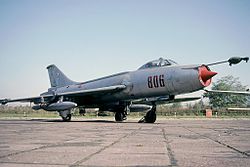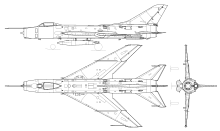Sukhoi Su-7
| Sukhoi Su-7 | |
|---|---|
 Su-7BKL of the Polish Air Force |
|
| Type: | Interceptor and bomb fighter aircraft |
| Design country: | |
| Manufacturer: | |
| First flight: |
1955 |
| Commissioning: |
1958 |
| Production time: |
1958 to 1976 |
| Number of pieces: |
1847 |
The Sukhoi Su-7 ( Russian Сухой Су-7 , NATO code name : Fitter ) is a single-seat Soviet fighter aircraft that was primarily used to attack ground targets. The designation Su-7 was used once for a test fighter in 1944.
development
The development of the Su-7, which was originally planned as an interceptor , began around 1950. 1955 flew the first prototype with the name S-1 Strelka ("стрелка", for swept wing) with pilot Andrei Kochetkow. A speed of 2170 km / h was achieved during the test program. On July 24, 1956, the Su-7 was presented to the public for the first time at the annual Tushino air parade .
The prototype S-2 was built in small numbers as the S-22 in 1958 and delivered to the Soviet armed forces. It was the pre-series of the Su-7B fighter-bomber version . The Su-7B is the conversion of the interceptor to the fighter-bomber and became the standard tactical fighter -bomb aircraft of the Soviet Air Force . Built from 1958 to 1976, the Su-7B was continuously improved, the successor model was the swivel-wing fighter-bomber Su-17 . The main versions were still the Su-7BKL with reinforced landing gear for use on unpaved slopes and the most frequently produced version, the Su-7BM with a stronger AL-7F-1 engine, two additional external load carriers under the wings, an improved ejection seat and a more powerful "Sirena 3" - Radar warning device. The two-seat variants Su-7U and Su-7UM were created for training purposes in 1966 .
The Su-7, designed as a mid-decker , has a 30-millimeter NR-30 cannon each with 70 rounds on the two wing attachments and can store bombs, rockets or rocket containers at two to four under-wing external load stations as well as additional fuel tanks at two fuselage stations with a total weight of carry up to 4000 kilograms. The V-shaped wings with a 62 ° leading edge sweep sit slightly below the center line of the main aircraft body, which houses the engine. Air is drawn in through the blunt nose of the aircraft.
Today, the Su-7 is only in the Air Force of North Korea in action.
Su-7 hijacked in 1973
In the middle of the Cold War , an aircraft technician from the Group of the Soviet Armed Forces in Germany (GSSD) deserted on May 27, 1973 in the German Democratic Republic and fled to the Federal Republic of Germany in a Su-7. First Lieutenant Vronsky was stationed with the 497th Fighter Bombing Regiment in Grossenhain and obtained flight skills in the simulator. Lacking knowledge of landing, he parachuted out of the plane between Klein Schöppenstedt and Hötzum in the Wolfenbüttel district, close to the city limits of Braunschweig, and applied for political asylum after a successful landing. The initial securing of the crash site was carried out by soldiers from the Hindenburg barracks, which are within sight.
Military users
-
 Egypt : 185 Su-7BMK / SU-7UMK
Egypt : 185 Su-7BMK / SU-7UMK -
 Afghanistan : 24 Su-7BMK + 16 Su-7U from 1972
Afghanistan : 24 Su-7BMK + 16 Su-7U from 1972 -
 Algeria : 22 Su-7BMK
Algeria : 22 Su-7BMK -
 India : 140 from 1968.
India : 140 from 1968. -
 Iraq
Iraq
-
 North Korea : 30 Su-7BMK / -7UMK
North Korea : 30 Su-7BMK / -7UMK -
 Poland : 6 Su-7BM, 33 Su-7BKŁ + 8 Su-7U from 1964 to 1990
Poland : 6 Su-7BM, 33 Su-7BKŁ + 8 Su-7U from 1964 to 1990 -
 Soviet Union
Soviet Union
-
 Syria : 60+ SU-7BMK + 5 Su-7UM from 1968 to 1991
Syria : 60+ SU-7BMK + 5 Su-7UM from 1968 to 1991 -
 Czechoslovakia : 64 Su-7BM, 31 Su-7BKL + Su-7U from 1963 to 1990
Czechoslovakia : 64 Su-7BM, 31 Su-7BKL + Su-7U from 1963 to 1990
Technical specifications
| Parameter | Data Su-7BM |
|---|---|
| crew | 1 |
| length | 17.37 m |
| span | 8.93 m |
| height | 4.57 m |
| Wing area | 27.60 m² |
| Wing loading | minimum 312 kg / m² maximum 489 kg / m² |
| Empty mass | 8,620 kg |
| Takeoff mass | maximum 13,500 kg |
| Tank capacity | internal 2,353 l external: two to four 1,200 l additional containers under the fuselage and inner external load carriers |
| drive | an afterburner jet engine Ljulka AL-7 F-1 with 98.1 kN static thrust |
| Top speed |
Mach 1.6 or 1,699 km / h at an altitude of 12,200 m (without external loads) Mach 1.1 or 1,352 km / h at sea level |
| Service ceiling | 15,150 m |
| Rate of climb | 152 m / s near the ground |
| Use radius | 250 km (with additional tanks) |
| Range | a maximum of 1,450 km with four additional tanks |
| Takeoff route | 2,400 m |
Armament
Fixed armament in the wing roots on each side
- 2 x 30 mm automatic cannon Nudelman-Richter NR-30 with up to 70 rounds of ammunition. Reinforcement plates were attached to the hull at the level of the cannon muzzle.
- Gun load of 2000 kg at six underwing stations
- Air-to-air guided missile
- 2 × BD-60-21U launch rails for 1 × Wympel R-3 S (AA-2 "Atoll") each - infrared-guided, self-targeting for short distances
- Unguided air-to-surface missiles
- 2 × UB-32-57UM missile tube launch container for 32 unguided S-5 air-to-surface missiles ; Caliber 57 mm
- 4 × UB-16-57UM missile tube launch container for 16 unguided S-5 air-to-surface missiles; Caliber 57 mm
- 6 × APU-12-40U launch rails, each with an unguided air-to-surface missile S-24 (ARS-240) ; Caliber 240 mm (235 kg)
- 4 × APU-14A launch rails, each with an unguided air-to-surface missile ARS-160 “Pika”; Caliber 160 mm
- Unguided bombs
- 4 × Basalt FAB-500 (500 kg free-fall bomb )
- 8 × Basalt FAB-250M-54 (234 kg free-fall bomb)
- 6 × Basalt FAB-100 (100 kg free fall bomb)
- 2 × RDS-4 (8U69 "Tatjana") (free - falling 5 kT nuclear bomb )
- External container
- 2 × UPK-23-250 machine cannon container (double-barreled 23 mm machine cannon GSch-23L with 260 rounds of ammunition)
- 2 × drop-off additional tanks for 950 liters of kerosene each
- 4 × drop-off additional tanks for 600 liters of kerosene each
literature
- Rainer Göpfert: Competitor of the MiG-21 - the Suchoi Su-7 . In: FLiEGERREVUE X . No. 69 . PPV Medien, 2018, ISSN 2195-1233 , p. 88-97 .
- Sukhoi Su-7 "Fitter" . In: de Agostini (ed.): Aircraft . The new encyclopedia of aviation. No. 126 . Topic, Munich-Karlsfeld 1995, p. 3506-3517 .
- Types of aircraft in the world . Models, technology, data. Bechtermünz, Augsburg 1997, ISBN 3-86047-593-2 , p. 865 (American English: The encyclopedia of world aircraft . Translated by Thema Produktmarketing und Werbung mbH, Munich).
Web links
Individual evidence
- ↑ Göpfert, page 92
- ^ Stefan Büttner: Soviet atomic bombs in Europe . In: Flieger Revue extraj . No. 22 , 2008, p. 30-53 .
- ↑ Rakshak, Bharat. Archived copy ( Memento from December 30, 2009 on the Internet Archive ) IAF History. retrieved; January 28, 2011.
- ↑ World Air Forces - Historical Listings Syria (SYR) https://web.archive.org/web/20130704123206/http://www.worldairforces.com/Countries/syria/syr.html accessed; June 11, 2018
- ↑ Wooruschenie Sowjetskoj Awiazij 1941-1991 . 2004, ISBN 985-13-2049-8 , pp. 478 .



